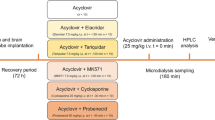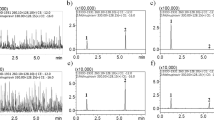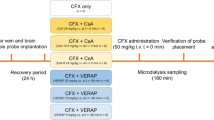Abstract
Purpose. Evaluate the ability of (-)-6-aminocarbovir ((-)-6AC) to improve the CNS exposure to (-)-carbovir ((-)-CBV).
Methods. Activation of (-)-6AC in vitro was assessed by incubations of rat brain tissue homogenates. The in vivo brain exposure to (-)-CBV was then examined in rats after iv infusions of either (-)-CBV (n = 4) or (-)-6AC (n = 5). The drugs were infused to steady-state via the jugular vein. At the end of the infusion, a bolus of [3H]inulin was injected via the femoral vein in order to obtain an estimate of the brain vascular space.
Results. (-)-6AC was converted to (-)-CBV by incubations of rat brain tissue homogenates. After iv infusion of (-)-CBV, the brain/ blood concentration ratio of (-)-CBV was 0.032 ± 0.009. The brain/ blood concentration ratio of (-)-CBV after iv infusion of (-)-6AC was 0.080 ± 0.020.
Conclusions. (-)-6AC improved the brain delivery of (-)-CBV, although the absolute exposure of the brain tissue to (-)-CBV was still quite low.
Similar content being viewed by others

REFERENCES
R. W. Price, B. Brew, J. Sidtis, M. Rosenblum, A. C. Scheck, and P. Cleary. The brain in AIDS: central nervous system HIV-1 infection and AIDS dementia complex. Science. 239:586–592 (1988).
P. Black. HTLV-III, AIDS and the brain. N. Engl. J. Med. 313(24):1538–1540 (1985).
T. Terasaki and W. M. Pardridge. Restricted transport of 3′-azido-3′-deoxythymidine and dideoxynucleosides through the blood-brain barrier. J. Infect. Dis. 158(3):630–632 (1988).
B. D. Anderson, B. L. Hoesterey, D. C. Baker, and R. E. Galinsky. Uptake kinetics of 2′,3′-dideoxyinosine into brain and cerebrospinal fluid of rats: intravenous infusion studies. J. Pharmacol. Expr. Ther. 253(1):113–118 (1990).
J. M. Gallo, L. N. Clark, and J. T. Rubino. Pump delivery of azidothymidine: potential for constant concentrations and improved brain delivery. J. Cont. Rel. 9:249–253 (1989).
R. E. Galinsky, B. L. Hoesterey, and B. D. Anderson. Brain and cerebrospinal fluid uptake of zidovudine (AZT) in rats after intravenous injection. Life Sci. 47:781–788 (1990).
R. E. Galinsky, K. K. Flaharty, B. L. Hoesterey, and B. D. Anderson. Probenecid enhances central nervous system uptake of 2′,3′-dideoxyinosine by inhibiting cerebrospinal fluid efflux. J. Pharmacol. Expr. Ther. 257(3):972–978 (1991).
A. Namane, C. Gouyette, M.-P. Fillion, G. Fillion, and T. Huynh-Dinh. Improved brain delivery of AZT using a glycosyl phosphotriester prodrug. J. Med. Chem. 35:3039–3044 (1992).
R. L. Lupia, N. Ferencz, J. J. L. Lertora, S. K. Aggarwal, W. J. George, and K. C. Agrawal. Comparative pharmacokinetics of two prodrugs of zidovudine in rabbits: enhanced levels of zidovudine in brain tissue. Antimicrob. Agents Chemother. 37(4): 818–824 (1993).
C. K. Chu, V. S. Bhadti, K. J. Doshi, J. T. Etse, J. M. Gallo, F. D. Boudinot, and R. F. Schinazi. Brain targeting of anti-HIV nucleosides: synthesis and in vitro and in vivo studies of dihydropyridine derivatives of 3′-azido-2′,3′-dideoxyuridine and 3′-azido-3′-deoxy thymidine. J. Med. Chem. 33:2188–2192 (1990).
R. Little, D. Bailey, M. E. Brewster, K. S. Estes, R. M. Clammons, A. Saab, and N. Bodor. Improved delivery through biological membranes. XXXIII. Brain-enhanced delivery of azidothymidine (AZT). J. Biopharm. Sci. 1:1–18 (1990).
M. E. Morgan, S.-C. Chi, K. Murakami, H. Mitsuya, and B. D. Anderson. Central nervous system targeting of 2′,3′-dideoxyinosine via adenosine deaminase-activated 6-halo-dideoxypurine prodrugs. Antimicrob. Agents Chemother. 36(10):2156–2165 (1992).
B. D. Anderson, R. E. Galinsky, D. C. Baker, S.-C. Chi, B. L. Hoesterey, M. E. Morgan, K. Murakami, and H. Mitsuya. Approaches towards the optimization of CNS uptake of anti-AIDS agents. J. Cont. Rel. 19:219–230 (1991).
R. Vince, M. Hua, J. Brownell, S. Daluge, F. Lee, W. M. Shannon, G. C. Lavelle, J. Qualls, O. S. Weislow, R. Kiser, P. G. Canonico, R. H. Schultz, V. L. Narayanan, J. G. Mayo, R. H. Shoemaker, and M. R. Boyd. Potent and selective activity of a new carbocyclic nucleoside analog (carbovir: NSC 614846) against human immunodeficiency virus in vitro. Biochem. Biophy. Res. Commun. 156(2):1046–1053 (1988).
C. L. Zimmerman, R. P. Remmel, S. S. Ibrahim, S. A. Beers, and R. Vince. Pharmacokinetic evaluation of (−)-6-aminocarbovir as a prodrug for (−)-carbovir in rats. Drug Metab. Disp. 20(1):47–51 (1992).
R. Vince and J. Brownell. Resolution of racemic carbovir and selective inhibition of human immunodeficiency virus by the (−)-enantiomer. Biochem. Biophys. Res. Commun. 168:912–916 (1990).
R. Vince and M. Hua. Synthesis and anti-HIV activity of carbocyclic 2′,3′-didehydro-2′,3′-dideoxy-2,6-disubstituted purine nucleosides. J. Med. Chem. 33:17–21 (1990).
Beers, J. Brownell, and R. Vince. Prodrugs of carbovir, a selective inhibitor of HIV: synthesis and enzymatic activation. Proceedings of 199th ACS National Meeting, MEDI#19 (1990).
R. P. Remmel, Y.-H. Yeom, M. Hua, R. Vince, and C. L. Zimmerman. Liquid chromatographic assay of carbovir, a carbocyclic nucleoside active against human immunodeficiency virus. J. Chrom. 489:323–331 (1989).
R. P. Remmel, S.-H. Huang, D. Hoff, and C. L. Zimmerman. Improved fluorometric high-performance liquid chromatographic assay for (−)-carbovir in rat blood and urine. J. Chrom. 534:109–118 (1990).
Q. R. Smith. Quantitation of blood-brain barrier permeability (Chapter 4). In E. A. Neuwelt (ed), Implications of the Blood-Brain Barrier and Its Manipulation, Plenum Medical Book Company, New York and London, 1989.
S.-H. Huang, R. P. Remmel, and C. L. Zimmerman. The bioavailability and nonlinear clearance of (−)-carbovir in the rat. Pharm. Res. 8(6):739–743 (1991).
K. R. Brouwer, R. L. St. Claire, J. Lagarde, J. E. Patanella, J. S. Walsh, and G. T. Miwa. The pharamcokinetics of (−)-carbovir in rats. Evidence for nonlinear elimination. Drug Metab. Disp. 18(6):1078–1083 (1990).
D. H. W. Ho, C. Pincus, C. J. Carter, R. S. Benjamin, E. J. Freireich, and G. P. Bodey, Sr. Distribution and inhibition of adenosine deaminase in tissues of man, rat, and mouse. Cancer Treat. Rep. 64(4–5):629–633 (1980).
Author information
Authors and Affiliations
Rights and permissions
About this article
Cite this article
Wen, YD., Remmel, R.P., Pham, P.T. et al. Comparative Brain Exposure to (-)-Carbovir After (-)-Carbovir or (-)-6-Aminocarbovir Intravenous Infusion in Rats. Pharm Res 12, 911–915 (1995). https://doi.org/10.1023/A:1016229624703
Issue Date:
DOI: https://doi.org/10.1023/A:1016229624703



